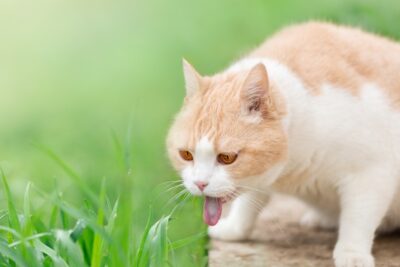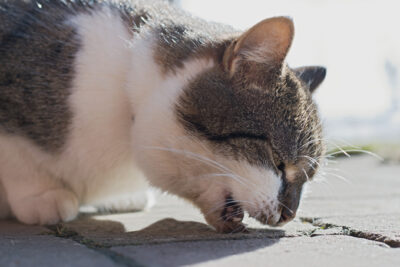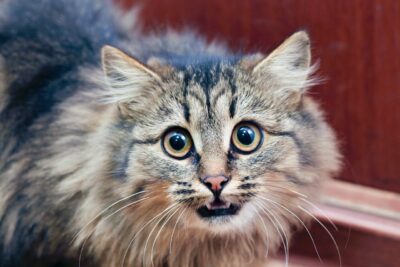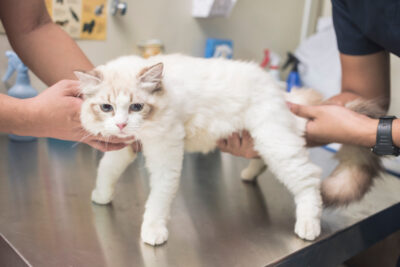Pale Gums in Cats: 8 Reasons It Might Be Happening

When was the last time you checked your cat’s gums? If you answered, “Um, never,” don’t fret. Unless you brush your cat’s teeth, the average pet parent isn’t peeking in their cat’s mouth too often. After all, it’s not typical cat fashion to open wide and say “ahhh” upon request. (If only it were that easy…but stay tuned for tips, because it’s not hard either.)
Why does checking your cat’s gums matter? Believe it or not, the gums give clues about your cat’s hydration, circulation, oxygen levels, and the presence of certain diseases. Pale gums in cats are a sign of serious health issues requiring veterinary attention. In this article, we’ll discuss pale cat gums vs normal-looking cat gums, possible causes, and what to do if you encounter paleness in your kitty’s gums.
Cat Gum Basics: What Color Should Your Cat’s Gums Be?
Healthy cat gums should be light pink, shiny, and moist, although some color variations are normal. Some cats (especially orange kitties) develop brown or black freckles on their gums, a harmless feature called lentigo (it usually appears on their eyelid margins, lips, and nose, too). Other cats may have more generalized dark pigmentation of their gums (especially black and gray cats).
Like our own gums, cat gums consist of a specialized tissue called a mucous membrane, which lines and protects many internal areas of the body. The gums act like a mirror of health, giving clues about several conditions. Some conditions may cause your cat’s gums to become inflamed or turn blue, purple, red, or yellow. (You can learn more about these here.)
Pink gums are an indication of good oxygen levels and blood flow. Conditions causing poor circulation (blood flow) or anemia (a reduction in red blood cells) will result in pale gums that may have a touch of pink or be completely white. Because adequate blood flow and oxygenation are so vital, problems with these can cause your cat to feel very unwell and are often life-threatening.
Assessing cat gum color is a quick and simple way to gain important information about your cat’s health. Try checking your cat’s gums anywhere from once a week to once a month.
How Do You Check Your Cat’s Gums?

Having help makes things easier to check your cat’s gums, but doing it on your own is entirely possible.
Choose a time when your cat is relaxed. Most cats love head, chin, and cheek rubs, so start with these to see if your kitty is up for being touched.
I prefer to hold the cat from behind, with my arms gently cradling the sides of their body. I give plenty of praise and pets while gently working my way to their mouth. Finally, I place one hand on top of their head and use the thumb of that hand to raise their upper lip.
A gentle and gradual approach is key to doing pretty much anything with cats. That said, not all cats will tolerate this, so if they put up a fuss, don’t push the issue.
8 Causes of Pale Gums in Cats
When gums appear pale or white, it’s due to a problem with either poor circulation or anemia (sometimes both).
Poor circulation occurs with conditions affecting blood flow. Sometimes only a select part of the body is affected (like frostbite on ear tips), whereas other times the entire circulatory system is compromised (such as with severe blood loss). Gums typically become pale when the entire circulatory system is affected.
Anemia occurs when there is a reduced number of red blood cells in circulation, either due to loss (bleeding), a problem producing new red blood cells, or hemolysis, which is the destruction of red blood cells resulting in hemolytic anemia. Hemolytic anemia usually leads to yellow gums.
Here are some of the most common causes of pale gums in cats:
1. Trauma
Getting hit by a car or attacked by a larger animal are common causes of trauma in cats. Severe bleeding (which can be internal, external, or both) is common with traumatic injuries. When this happens, the body tries to cope by prioritizing blood flow to vital organs. If there is more blood loss than the body can cope with, permanent organ damage or death may occur.
2. Parasites
Some of the most common parasites in cats are voracious bloodsuckers. Hookworms (an intestinal parasite), fleas, and ticks all feed on blood. If the infestation is large enough, blood loss can result in parasitic-induced anemia. Kittens and sick or debilitated cats have the highest risk of developing life-threatening anemia.
3. Infection

Feline Leukemia Virus (FeLV) and Feline Immunodeficiency Virus (FIV) are viruses that suppress the immune system and can impair the bone marrow’s ability to create new red blood cells, leading to anemia.
4. Clotting Problem
A complex system of specialized blood proteins and cells (platelets) are responsible for clotting. They’re constantly at work, and without them, even the smallest bruise or cut would bleed uncontrollably.
One of the most notorious causes of clotting problems in cats is accidental poisoning with anticoagulant rodenticide (rat bait). Affected cats may have pale, bleeding gums, nose bleeds, trouble breathing, bloody vomit or urine, and weakness; however, signs vary greatly, depending on where the bleeding is happening in the body.
It’s rare, but some cats are born with a clotting disorder, the most common being Haemophilia A or B. Both conditions result in deficient levels of a clotting factor (specialized blood protein) essential for clotting.
Liver failure and severe blood infections (sepsis) may also result in clotting problems in cats.
5. Cancer
The effects of cancer are vast and varied, depending on the cancer type and area of the body that’s affected. Cats may become anemic from internal tumors that chronically bleed or suddenly rupture. (Internal tumor rupture is much less common in cats than dogs.) More common feline cancers, like lymphoma, can invade the bone marrow, interfering with the production of new red blood cells, while other cancers may trigger hemolytic anemia.
6. Chronic Kidney Disease (CKD)

Chronic kidney disease is one of the most common conditions affecting senior cats. Cats with CKD may experience weight loss, lethargy, poor appetite, and the need to drink and pee excessively.
Some cats with CKD are prone to anemia, which can reduce their lifespan and quality of life. Healthy kidneys produce a substance called erythropoietin, which stimulates the bone marrow to produce red blood cells, but this process is impaired in cats with CKD.
Additionally, toxins that are normally eliminated by the kidneys can build up in the bloodstream and cause red blood cell fragility, meaning they don’t last as long in circulation.
7. Heart Disease
The most common type of feline heart disease is called hypertrophic cardiomyopathy, a condition causing the walls of the heart muscle to thicken. As the disease advances, the heart cannot pump blood effectively through the body, leading to poor circulation and serious complications such as congestive heart failure or a saddle thrombus (large blood clot).
8. Shock
Shock is a state where the body’s ability to cope with a disease or injury has been overwhelmed. There are a few types of shock, but it generally occurs when there is inadequate delivery of oxygen to the tissues. The risk of permanent organ damage or death is high.
Many different conditions can lead to shock, such as severe dehydration, anaphylaxis (major allergic reaction), sepsis, hypothermia, certain toxins, and traumatic injuries.
What to Do if Your Cat Has Pale Gums

If your cat’s gums are obviously pale or white, this is an emergency. Typically, other signs will be present, such as lethargy, weakness, and rapid breathing. The best thing you can do is keep them warm and get them to the veterinarian right away.
If the cause is due to visible blood loss, apply pressure to the wound with a clean towel until you can get to your veterinarian. If possible, have someone help you tend to your cat and get you to the animal hospital.
What if your cat has pale gums but is acting normal? Some conditions that cause pale gums, such as mild, slowly developing anemia, don’t present as dramatically, and cats may not show many signs that something is amiss. A slight pallor to the gums can be hard for even the most discerning pet parent to notice. Also, gum color may fluctuate slightly without your cat being seriously ill. If you are unsure about your cat’s gum color, contact your veterinarian for advice.
How to treat pale gums in cats depends on the cause, and in most circumstances, the cause won’t be immediately clear. For pale cat gums, a veterinary assessment and diagnostic testing will be necessary in order to receive an accurate diagnosis and treatment plan.
How to Prevent Pale Gums in Cats

Unfortunately, we can’t always prevent our cats from getting sick; however, there are some steps you can take to reduce the risk of conditions that cause pale gums.
Consider staying indoors. Whether to keep your cat inside or let them outdoors is a personal choice, but on average, we know indoor cats live longer, healthier lives than outdoor cats. Outdoor cats are much more likely to have a traumatic injury. They’re also more exposed to parasites and infections, and more at risk of hypothermia in cold climates.
Be aware of toxins. It’s important to learn about common toxins in cats and keep these away from your furry friend.
Don’t forget checkups. Regular veterinary check-ups are a crucial part of keeping your cat healthy and identifying problems early. During a routine examination, your veterinarian can assess your cat’s overall health, identify possible concerns, and provide vaccines and parasite control that protect your cat.









